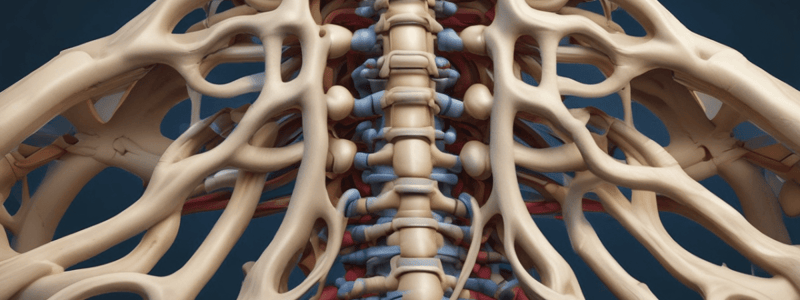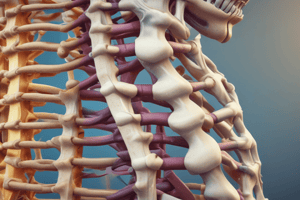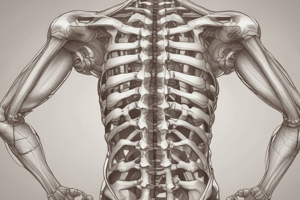Podcast
Questions and Answers
The passive segment in the vertical plane is formed by the intervertebral disc.
The passive segment in the vertical plane is formed by the intervertebral disc.
False (B)
The mobile segment consists of the intervertebral foramen and the costal joints.
The mobile segment consists of the intervertebral foramen and the costal joints.
False (B)
The pedicles form the functional link between the anterior and posterior pillars.
The pedicles form the functional link between the anterior and posterior pillars.
True (A)
Each vertebra has a trabecular structure involving the body and the transverse process.
Each vertebra has a trabecular structure involving the body and the transverse process.
The articular process acts as the fulcrum in a third-class lever system in the vertebral motion segment.
The articular process acts as the fulcrum in a third-class lever system in the vertebral motion segment.
Axial compression forces acting on the column are cushioned directly and passively by paravertebral muscles.
Axial compression forces acting on the column are cushioned directly and passively by paravertebral muscles.
Available movements at the interbody joints include gliding, distraction, and tilt, but not rotation.
Available movements at the interbody joints include gliding, distraction, and tilt, but not rotation.
The vertebral column has 6 degrees of freedom.
The vertebral column has 6 degrees of freedom.
The stiffness of the vertebral column refers to its ability to resist deformation under load.
The stiffness of the vertebral column refers to its ability to resist deformation under load.
Axial compression on the vertebral column is only caused by the force of gravity.
Axial compression on the vertebral column is only caused by the force of gravity.
Fluid expression from the nucleus pulposus and annulus fibrosus happens under sustained tensile loading.
Fluid expression from the nucleus pulposus and annulus fibrosus happens under sustained tensile loading.
Gravity does not play a role in causing axial compression on the vertebral column.
Gravity does not play a role in causing axial compression on the vertebral column.
The vertebral column's ability to resist loads is independent of the person's age and posture.
The vertebral column's ability to resist loads is independent of the person's age and posture.
The vertebral disk imbibes fluid back from the vertebral body when compressive forces are increased.
The vertebral disk imbibes fluid back from the vertebral body when compressive forces are increased.
Bending Compression Bending only causes compression on the structures of the spine.
Bending Compression Bending only causes compression on the structures of the spine.
In forward flexion, the anterior structures of the spine are only subjected to compression.
In forward flexion, the anterior structures of the spine are only subjected to compression.
Tensile forces from collagen fibers in the posterior outer anulus fibrosus help limit motion in flexion.
Tensile forces from collagen fibers in the posterior outer anulus fibrosus help limit motion in flexion.
In extension, the anterior structures of the spine are subjected to compression.
In extension, the anterior structures of the spine are subjected to compression.
The resistance to extension in the spine is provided by passive tension in the posterior longitudinal ligament.
The resistance to extension in the spine is provided by passive tension in the posterior longitudinal ligament.
During lateral bending, the ipsilateral side of the disk is stretched.
During lateral bending, the ipsilateral side of the disk is stretched.
Mechanical changes in the disk with creep loading only affect the neural arch.
Mechanical changes in the disk with creep loading only affect the neural arch.
In the presence of prolonged compressive forces, the load shifts from the annulus fibrosus to the nucleus pulposus.
In the presence of prolonged compressive forces, the load shifts from the annulus fibrosus to the nucleus pulposus.
Buckling or prolapse of the anulus fibrosus can be caused by decreased load on the annulus fibrosus.
Buckling or prolapse of the anulus fibrosus can be caused by decreased load on the annulus fibrosus.
Creep-induced elongation of supporting structures can enhance stability.
Creep-induced elongation of supporting structures can enhance stability.
Torsional forces are generated during axial rotation.
Torsional forces are generated during axial rotation.
The thoracolumbar junction has the lowest torsional stiffness in the vertebral column.
The thoracolumbar junction has the lowest torsional stiffness in the vertebral column.
Torsional stiffness is primarily provided by the inner layers of vertebral bodies.
Torsional stiffness is primarily provided by the inner layers of vertebral bodies.
In torsion, all annulus fibrosus fibers resist clockwise rotations.
In torsion, all annulus fibrosus fibers resist clockwise rotations.
The lumbar region is least effective in resisting torsion.
The lumbar region is least effective in resisting torsion.
Combining torsion with heavy axial compression and bending decreases the risk of disk fiber rupture.
Combining torsion with heavy axial compression and bending decreases the risk of disk fiber rupture.
Torsional forces do not contribute to the risk of injury to vertebral structures.
Torsional forces do not contribute to the risk of injury to vertebral structures.
Flashcards are hidden until you start studying




